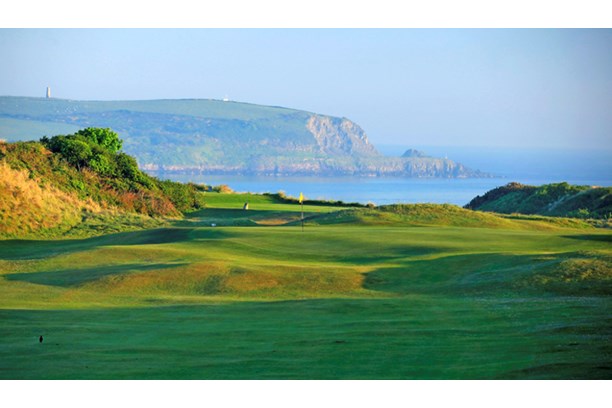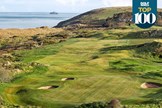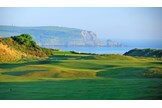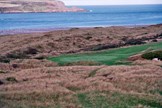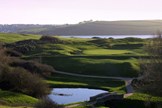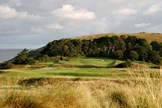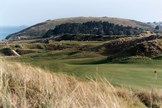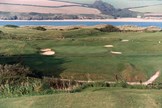St Enodoc Golf Club
Last updated:
What we say
Some of the world’s best golfers love St Enodoc and it isn’t hard to see why…
Ah! Seaweed smells from sandy caves
And thyme and mist in whiffs,
In-coming tide, Atlantic waves
Slapping the sunny cliffs,
Lark song and sea sounds in the air
And splendour, splendour everywhere.
RELATED: Golf World Top 100: Best Links Golf Courses in Great Britain and Ireland
A degree in English Literature is not required in order to appreciate the closing stanza of Sir John Betjeman’s ‘Seaside Golf’. All that is necessary to enjoy the late Poet Laureate’s tribute to the 13th at St Enodoc is an affection for links golf.
That he captures so eloquently the joy of seaside golf at St Enodoc is not surprising given his literary status and the fact he adored this seaside course of heroic individual holes.
Betjeman was a Londoner but later in life retreated to the Cornish village of Trebetherick next to St Enodoc’s Church course. He is buried in the churchyard that sits between the 10th green and 13th fairway.
It is not difficult to understand why the poet – who holidayed in the county as a child – set down roots in this corner of the Duchy, the rugged, winding, north-east bank of the Camel estuary being so appealing to so many that it has become one of England’s ‘fashionable’ destinations.
St Enodoc’s two links (the Holywell was originally nine holes and after closing during WW2 became full size in 1982) sit on the edge of the village of Rock, hailed as ‘Britain’s St Tropez’ owing to its popularity with affluent holiday-makers including celebrities such as Hugh Grant and Jemima Khan.
But don’t let that stop you visiting. Outside mid-summer you won’t be over-run with paparazzi or Jack Wills-clad schoolboys from Harrow.
And once on the links you are more likely to encounter a world-class golfer; Tom Watson is an admirer, describing it as “a wonderful course with a lot of variety” while Luke Donald played there last year and called it “a gem of a links”.
European Tour player Chris Wood, who hails from the south-west, regularly uses St Enodoc to hone his putting by virtue of the fast, undulating greens.
COURSE REVIEW: St Mellion Golf Club
These contemporary stars have followed Betjeman – as well as King George VI, two Prince of Wales, Edward VIII (a former president of the club), and golfing royalty in Henry Cotton and Jim Barnes – in being captivated by a section of England’s coast reputed to have hosted golf for nearly 130 years.
It’s suggested undergraduates played golf in the area around the church overlooking Daymer Bay – the northern end of the property – as early as 1888. A year later holes were more permanently laid out further south in the huge dunes around Rock and by the start of the new decade a fledgling club had been formed; St Enodoc has just finished a year of 125th anniversary celebrations.
Extra land was secured as the new century dawned and in 1907 James Braid laid out the full course, the majority of which remains in place today.
Just shy of a century later, Peter McEvoy undertook a subtle review of the links in order to tighten the test, with new fairway bunkers and additional tees created along with a new 13th green and lengthened 16th.
COURSE REVIEW: Trevose Golf Club
“We didn’t want to be prisoners to length, so many of the changes are subtle and strategic,” says then-secretary Tuck Clagett, a friend of Watson’s from their prep school days. “It was vital we retained the characteristics that have made St Enodoc famous around the world but we must also appreciate technological advances had blunted the teeth of some of the holes.”
Tom Doak has since cast his eye over the links and had his team tweak and tighten here and there.
Two of the Church’s holes usually receive more attention that the rest, with the St Enodoc experience often defined by the 10th and if not it then the 6th.
The former winds towards the 11th Century church and requires an accurate drive followed by an even better second, gently drawn off the church spire. Watson took six (3-wood, 4-wood, SW, SW, and two putts) here.
The fame of the 378-yard 6th, meanwhile, emanates from the Himalaya bunker, which is touted as golf’s biggest sand trap and to the naked eye certainly seems to dwarf other notable candidates.
It used to be bigger, too.
At driving distance it turns left and the enormous sand crater sunk into a dune – like a scoop of ice cream out of a tub – obstructs the view to the uphill green.
A hidden fairway bunker can snare longer players seeking a view for their approach unobstructed by Himalaya, whose fame was extended by the Joshua Smith painting of it featuring on the cover of Doak’s waspish ‘Confidential Guide’.
They are holes of renown and distinction, but they are far from all you get from St Enodoc. They might well not, indeed, even be the two best holes here.
That honour could go to plenty of the 12 that sit on the clubhouse side of the valley that dissects the famous 10th and short, downhill 15th.
While effort has been made in enhancing the loop after 10 and before 15, they are not quite of the standard of the rest. On most courses in England they would not be pinpointed so, but the rest of St Enodoc is not like most courses in England. Even allowing for this more modest quartet, no more than a handful of England’s superstar courses are notably ‘better’ than St Enodoc. For those who relish ingenious, enthralling golf and don’t mind a mild trough with these many peaks, it could easily appear in their top five.
St Enodoc does memorable holes of differing character better than most, a quality that is evident immediately. While some links take a hole or two to hit even moderate pace, St Enodoc instantly makes you stop and stare with an opening par of a rare calibre. Played along a tumbling fairway between sizeable dunes towards the estuary and Padstow beyond, it will not fail to find favour with links lovers.
An uphill 2nd that is a three-shotter for most of us reveals the often significantly rolling topography that define St Enodoc’s holes, because having battled up the hill, now you come down for the 3rd. Played on the outer edge of the property alongside farmland, it loses its obvious links feel and the 4th follows that line, a terrific sporty par 4 whose green is reachable for some. But with its green set at an angle to the fairway, the field hard to the right being OB and with nasty cabbage to the left, it is a bold play to reach for driver with scorecard in hand
Either side of the aforementioned 6th and blind drive off the 7th are two par 3s. The 5th is a gorgeous short hole, the 8th a brilliant one. In well-honoured links fashion, the latter is so exposed to the elements that it can require anything from a wedge to a hybrid to try to avoid the seven greenside traps.
A straightforward downhill par 4 to a green overlooked by tall pines concludes a front nine where no two holes play in the same direction and where the relentless questions asked off the tee and the variety of challenge give this 6,557-yard links its bite and its appeal.
Survive the 10th and your reward is a 232-yard short hole at 11, which starts the journey around the church on land with more parkland-moorland feel. McEvoy’s work has improved definition and at 396, 395 (uphill) and 382 yards, they are exacting (and in the 14th’s case, with a super view) if not as romantic.
The 15th returns you to the elite level, a downhill 15th par 3 with a backdrop of the Camel where you are never confident of your club selection.
A high-octane finish is required and begins with the 16th, always a very pretty par 5 played alongside the beach but which now been lengthened by 70 yards and with a first-class new green complex it has plenty of bite and much more allure.
A robust par 3 (St Enodoc’s longest) set between two mounds maintains the momentum before St Enodoc finishes as it began, with a stellar hole. It is not technically a par 5, as is the 1st, but for most of us it is one in all but name.
The raised green is visible from the elevated tee but with OB on the right and thick rough to the left of the undulating, snaking, often narrow fairway, covering its 469 yards in regulation is unlikely for most. A five is a fine finish and worse is no disgrace. Certainly it won’t overshadow the enjoyment taken from this magnificent links.
As Betjeman notes in the opening stanza of ‘Seaside Golf’, this links “made me glad I was alive”.
Golf World Top 100: Best Golf Courses & Resorts
-
Course Summary
- Costs -
- TG Rating
- Players Rating
- Address Rock, , WADEBRIDGE
- Tel 01208 863216
- Website www.st-enodoc.co.uk
Course Information
| Course | 69 par |
| Course Style | - |
| Green Fees | - |
| Course Length | 6,557 yards (5,996 metres) |
| Holes | - |
| Difficulty | - |
| Course Membership | - |
Course Features
- Course has: Bar
- Course does not have: Buggy Hire
- Course has: Driving Range
- Course does not have: Practice Green
- Course has: Pro Shop
- Course has: Restaurant
- Course has: Trolley Hire
- Course does not have: Dress Code
- Course has: Club Hire
- Course has: Handicap
Your Reviews
-
Cornish Links
Epic links course with fantastic views of the Camel estuary. Not as difficult as you might expect in the wind as it's quite a 'short' course at under 6,400 yds. Not to be missed.

